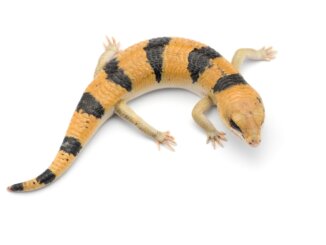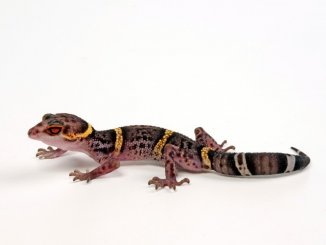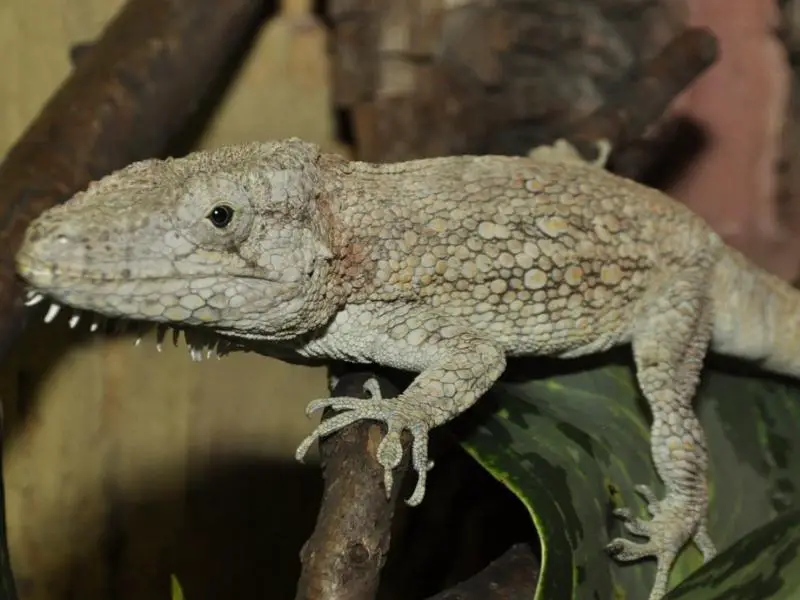
Cuban false chameleons are lizards originating from Cuba that are known for their unusual physical characteristics. As the lizards’ name implies, these animals are not real chameleons.
Cuban false chameleons are shy and quiet with a pleasant temperament, making them easy to care for and to keep as household pets.
Cuban False Chameleon Overview
| Common name | Cuban false chameleon |
| Scientific name | Anolis barbatus |
| Natural habitat | Broadleaf forests |
| Adult size | 7 inches |
| Average lifespan | 8–15 years |
| Diet | Omnivores |
| Housing | Glass with a screen lid and a width of 2 feet, length of 1.5 feet, and height of 2 feet |
| Experience level | Beginner to intermediate |
Origin
The Cuban false chameleon is part of a family of reptiles that belongs to the species Anolis barbatus of the Dactyloidae family. This family of reptiles’ origins is in South America, but due to changes in geographic structures in the region, the Cuban false chameleon has become localized in the forests of Cuba. These lizards are also found in coffee and fruit plantations as well as in some urban settings.
In their natural habitats, Cuban false chameleons are shy creatures that usually stay hidden in tree branches. Like ordinary chameleons, Cuban false chameleons can camouflage and blend in with their surroundings to make it difficult for predators to find them.
Appearance and Behavior
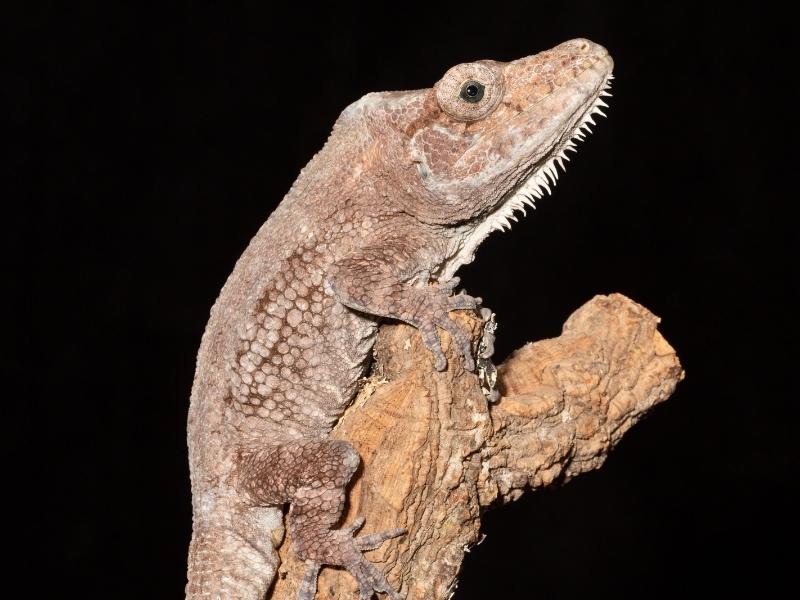
Male and female Cuban false chameleons don’t vary much in appearance. The lizards are considered to be mid-sized, but their short tails and limbs (along with their claws) keep them agile in trees and on branches. These lizards are more slender than other lizard species.
The Cuban false chameleon has a peculiar look that results from a bony protrusion, called a casque, on the rear of the lizard’s head.
Reptiles are known to have very limited eye movement due to poorly developed eye muscles and tend to depend on neck movement to view their surroundings. However, Cuban false chameleons are an exception and have an eye structure similar to that of real chameleons, allowing a better range of vision that helps the lizards target their prey.
Size and Lifespan
Both male and female Cuban false chameleons grow to approximately 7 inches in length. Cuban false chameleons have a long lifespan, averaging between 8 to 15 years.
Temperament
Cuban false chameleons are generally shy, quiet, and inactive in both their natural habitat and captivity. These lizards rarely bite. These reptiles get stressed easily, so they should not be handled frequently.
When this species feels stressed or panicked, it will open its mouth and stick out its tongue as a warning sign, which may be followed by a bite. Leave the lizard alone if it demonstrates this behavior.
Male Cuban false chameleons tend to be territorial, especially in the presence of females. Males may become aggressive towards each other and fight, so keep male lizards in separate enclosures.
Housing Cuban False Chameleons
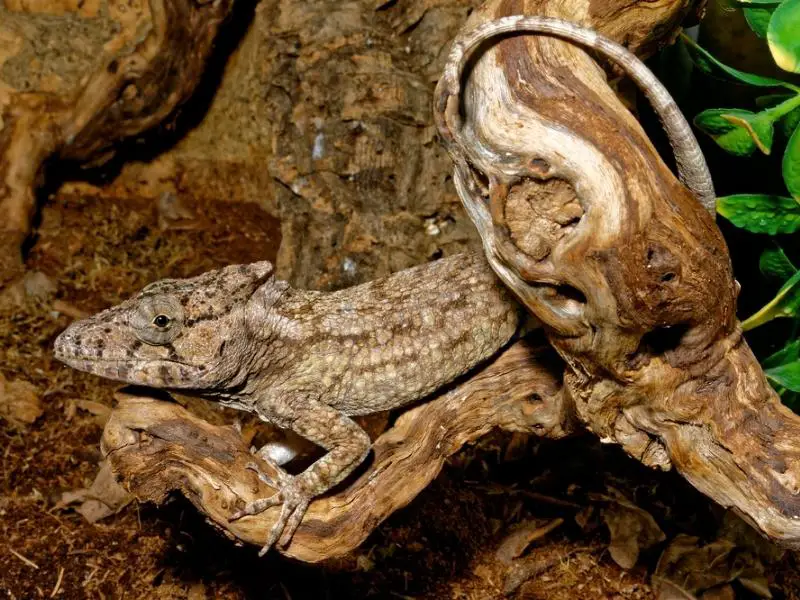
The Cuban false chameleon’s natural habitat is mostly in trees in broadleaf forests. Keep this reptile in a glass vivarium with a height of at least 2 feet to allow the lizard to move and climb within the enclosure.
Enclosure size
The ideal dimensions of a Cuban false chameleon’s glass vivarium are 2 feet by 1.5 feet by 2 feet. Since Cuban false chameleons are used to being in trees, provide a habitat that is tall enough to accommodate branches or decorations the chameleon can climb and perch on.
Consider placing a screen lid, partially covered with foil, on top of the vivarium to help control humidity inside.
Lighting
In the wild, reptiles benefit from natural light — a source of vitamin D — which helps them process calcium and promotes bone health. To replicate natural light in captivity, install a UVB light source on top of the vivarium. Make sure the Cuban false chameleon gets at least 10 hours of UVB light exposure per day.
A basking light is also recommended — usually, a 50-watt spotlight, placed around 10 inches above a designated basking spot inside the vivarium. Reptiles in the wild often perch on top of rocks to warm up under natural sunlight, and a basking light simulates this experience.
Temperature and Humidity
The temperature inside the vivarium should be kept at around 70°F, while the temperature in the basking area should be kept at around 90°F. Add a digital thermostat to the vivarium to monitor temperatures and ensure they remain constant.
Lizards easily suffer from dehydration, so make sure to keep humidity inside the enclosure constant as well. Humidity should be set to around 70%. During dry seasons, spraying the enclosure with water may be necessary to keep humidity at the right level. Adding live plants to the enclosure also greatly helps maintain humidity.
Substrate and Decoration
To help maintain a humid environment for the Cuban false chameleon, line the vivarium with a substrate that will provide moisture — like damp moss, soil, sand, or wood shavings. Make sure the vivarium has proper drainage so that the substrate doesn’t become too wet.
Bioactive substrates can also be used. These types of substrates contain bacteria and other microorganisms that break down waste accumulating in the enclosure, which reduces the need to replace soiled substrates and saves maintenance time.
For decor, add driftwood and branches measuring around 1½ to 2⅓ inches in diameter, placed where the lizard can make use of climbing skills. A basking spot, like a flat piece of rock, should be placed in one corner of the vivarium with a basking light placed right above it.
Cleaning
Deep clean the Cuban false chameleon’s vivarium once every two to three months. Make sure to remove the reptile from the enclosure before the deep cleaning. Clean the enclosure using warm water and dishwashing soap. Then disinfect using a 10% bleach solution. Dry the enclosure before placing the Cuban false chameleon back inside.
Spot clean the enclosure every day by removing any feces or leftover food from the tank.
Cuban False Chameleon Care
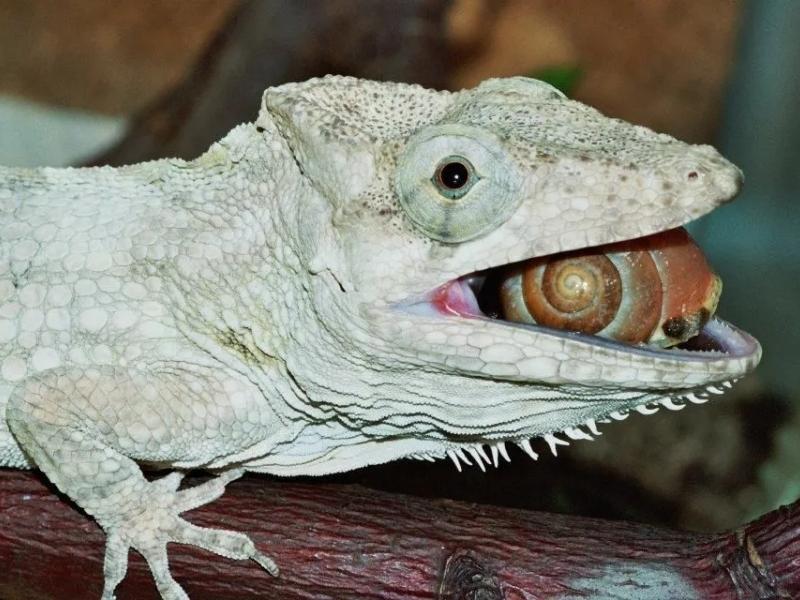
Cuban false chameleons are easy to care for and maintain. The lizards are easy to feed and don’t require much attention compared to other types of pets.
Food and Water
Cuban false chameleons need to remain constantly hydrated, so make sure the lizards always have access to water.
Although Cuban false chameleons can drink water from a bowl, they prefer to drink water that drips onto a flat surface like a leaf or a flat rock. To accommodate this preference, install a drip system and aim it toward a flat surface.
These lizards’ diets usually consist of snails and insects. Buy snails from reputable breeders and feed the snails to the lizards using tongs, around twice a week.
Cuban false chameleons also feed on crickets. Carefully use tongs when feeding crickets because crickets left to roam inside the vivarium may bite the lizard.
Handling
Cuban false chameleons are quiet creatures that do not like being handled much. The animals are easily stressed and startled and may bite.
The best way to handle a Cuban false chameleon is by sliding your hand under its feet from behind and then picking it up.
If the chameleon suddenly opens its mouth and sticks out its tongue, consider this behavior a warning sign that the lizard is stressed and may bite, and leave the lizard alone.
Common Health Issues
One of the most common health issues that affect Cuban false chameleons is dehydration. Dry, rough skin and sunken eyes are common signs of dehydration. To prevent dehydration, make sure the lizards always have access to water and maintain the correct humidity level.
Cuban false chameleons may also suffer from eye infections and corneal ulceration, resulting in eye redness.
If you suspect a lizard is suffering from these illnesses, take it to a veterinarian for inspection and potentially an antibiotic prescription. Eye surgery may be required in extreme cases.
Other common diseases include respiratory infections, skin problems, bacterial infections, and parasites. Respiratory issues are most likely to occur when humidity and temperature levels are not right, and parasites and bacterial infections occur when these lizards are kept in an unhygienic home.
To avoid disease, keep the lizard’s enclosure clean and within the correct humidity and temperature parameters.
Breeding
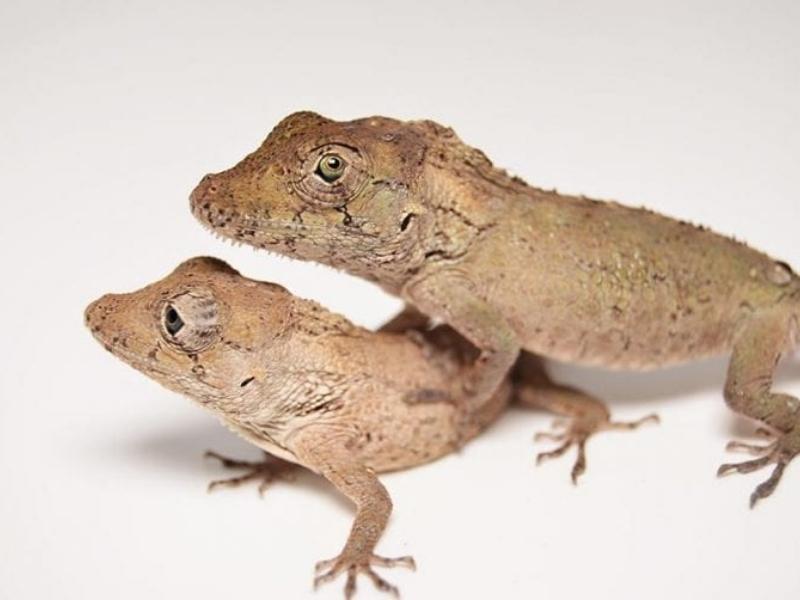
Cuban false chameleons are easy to breed because females ovulate automatically and can breed during any time of the year. To breed, to keep one pair of male and female Cuban false chameleons in an enclosure. Alternatively, one male lizard can be placed with two to three other females.
To avoid aggressive behavior among males, never put two males inside the same cage.
Pregnant females don’t exhibit many behavioral changes, but they may tend to stay at the bottom of the cage rather than perching on branches. Females tend to cover their eggs with substrate once they’re laid, so be careful when cleaning the tank.
Females lay eggs every 30 days. While the female is laying eggs, supplement her diet with calcium by dusting calcium on the crickets and insects you feed her.
Choosing and Buying a Cuban False Chameleon
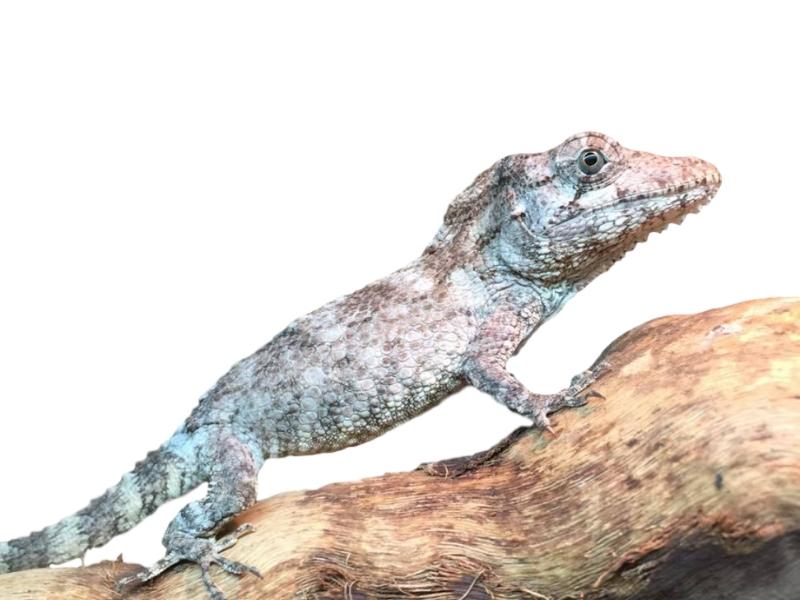
Cuban false chameleons are quite common and are popular house pets in the United States because the lizards are legal to keep in all states.
The lizards can be easily purchased from breeders as well as chain pet stores like PetSmart. A Cuban false chameleon usually costs between $150 and $300 but may cost up to $500, depending on the color of the lizard.
After purchasing a lizard, the yearly costs of keeping the pet can total up to $1,500 per year.
Before purchasing a Cuban false chameleon, make sure it’s healthy and free from disease. The lizard’s eyes should not be red, and the skin should not look rough or dry.
Cuban false chameleons make good pets for beginner reptile keepers because the lizards are friendly, calm, and easy to care for.

